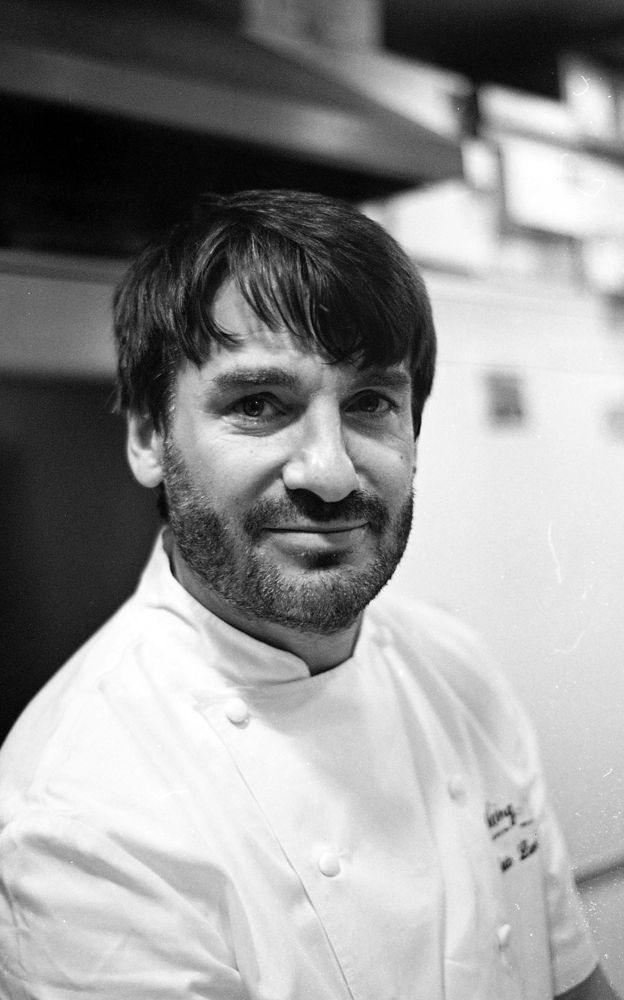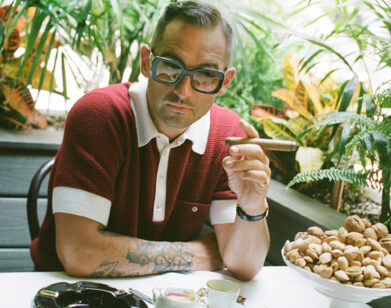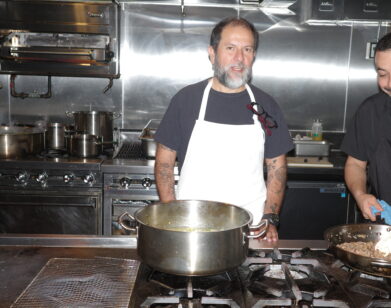Making Tarts With Eric Lanlard
ABOVE: ERIC LANLARD AT CAKE BOY IN LONDON. PHOTOS BY VITA HEWISON.
Crumbs, Magnolia, Sprinkles, Baked by Melissa; specialty cake shops litter the streets of New York. Once relegated to bake sales and first-graders, the cupcake is now as commonplace as ice cream, and no one is happier about this than French-born, London-based pastry chef Eric Lanlard. “Long may it last,” says Lanlard over the phone. “A few years ago, I remember I tried to talk to TV producers about doing baking programs, cake programs, and they almost laugh at you: ‘Nobody is interested in making cakes, that’s for the old woman from the women’s institute.'”
Lanlard is somewhat of a celebrity in England. He caught the public’s attention by making wedding and birthday cakes for the likes of Madonna and Guy Ritchie, Elizabeth Hurley, Claudia Schiffer, the Beckham children, and even the Queen Mother—and turned this into television programs (Baking Mad with Eric Lanlard, and Glamour Puds, which aired in the UK), baking cookbooks (Glamour Cakes; Homebake; and Cox, Cookies, and Cake, written with shoes designer Patrick Cox), and an ever-growing London shop, Cake Boy. Lanlard fits in well with his high-profile clients; he’s nice-looking and well-groomed—a chef who constructs elaborate and aesthetically pleasing pastries while wearing his Cartier “Love” bracelet. His credentials are impressive: He spent five years as the head pastry chef for Michel and Albert Roux, who own and run the three-Michelin starred London power restaurant, Le Gavroche.
Tart It Up, Lanlard’s latest book that comes out next week, is a bit of a departure for Lanlard, as it focuses on savory, as well as sweet, tarts and pies. We recently spoke with the chef about his new book, space tourism, the French Navy, mangos, the future of cupcakes, and his favorite thing to bake.
EMMA BROWN: What’s the first thing you learned to cook? Did you grow up baking with your parents?
ERIC LANLARD: I really went on my own to do it. My parents were busy—always at work—so when we had time off from school, I would always go in the kitchen and try to experiment, which would, most of the time, end up in disasters because I didn’t have the right ingredients or I didn’t know what I was doing. I was a little bit too ambitious, I never went for the simple recipe; I went for the most complicated one, which really needed specialized ingredients or equipment.
BROWN: I heard that you were in the French Navy.
LANLARD: After I did my apprenticeship I had to do, like every French minor boy has to do, national service. I decided to go into the Navy because I did very well with my exams during my apprenticeship as a pastry chef [and] there was a position to be the captain’s pastry chef on board the flagship ship of the French navy. It was a great experience. We went away for five months on a trip to 17 different countries, [meeting] diplomats and ministers and presidents. It was hard work, but it was great. Definitely an eye opener on the world.
BROWN: How did you get the ingredients that you needed? Would you get them from every port you stopped in?
LANLARD: We took all the dry ingredients as we left France; we had to stock up on good quality chocolates and all the stuff that we would keep on board. We were very lucky because that ship has the second highest budget, food-wise, after the Palais de l’Élysée in Paris. We had an amazing food budget, which is mind-blowing, when you’re in charge of a checkbook like that. Every time we arrived in a country, the ambassador of the country would come on board and the first person to get out [of the ship] would be me, the chef, and the butler of the captain. We’d go straight to the local markets and get fresh ingredients, local ingredients if we [could]. I discovered some ingredients, which I had never seen before—maybe I had seen them before in a supermarket, but definitely not as fresh and as tasty as they were straight from the market store in the Caribbean or Mexico or Tahiti.
BROWN: When you hear the words “pastry chef,” you automatically think of sweet things, did your apprenticeship include making savory tarts? There’s lots of savory recipes in Tart it Up.
LANLARD: Yeah, it did. Savory baking is part of your training and any good pâtisserie in France will have a little section with some savory tarts or pies. It’s quite a big family thing as well, the French love eating savory tarts and pies. People think that pies are something stodgy and heavy that you’d only be eating in the winter, but in France you eat the pies all year round. You can put a light filling inside, it doesn’t have to be something very heavy. With a background as a pastry chef, the pastry is much lighter. It’s made with butter, so it’s not all these weird fats like beef suet, which I still don’t understand after 22 years [living] in [England].
BROWN: There’s a mango and green peppercorn recipe in your book. How did you come up with that combination? I would never think to put those two things together.
LANLARD: When you eat a ripe mango, it’s quite peppery. If you eat the big, large mangos and you smell them, it’s actually a very peppery taste, so that’s how I came up with that. Obviously, it’s fresh peppercorns, not the dry ones. It doesn’t crunch, it’s a soft fruit, which you get in little tins in brine. I know it’s a bit odd, but it does work and it enhances the natural taste of the mango.
BROWN: Did you get sick of eating tarts while you were writing Tart it Up?
LANLARD: Yes, we kind of did. It was a lot of savory baking as well, for the first time. Usually I don’t eat anything sweet—I haven’t got a sweet tooth—but this time we had so many savory tarts and pies and I couldn’t stop eating it, so I did put on weight during the shoots [for the book]. [laughs] I have to be a bit careful. When you do a book, you think about your tummy first, the things you like. Of course, you look at some of the trends, but usually it will be things I really like or ingredients I really like. When you do a shoot, you do eight products roughly a day, and you have eight finished products standing there. Someone has to eat that, you can’t waste that. [laughs]
BROWN: There’s a rumor that you are going into space. Is that true?
LANLARD: This is true. I signed up with the Virgin Galactic over six years ago now and it looks like it’s getting closer and closer. The development is quite great and I think we’re looking at early 2014, or maybe even 2013, for the flight. I’m flight number 30, so there are quite a few people before me, which is great.
BROWN: Yes. Work out the kinks with the other people.
LANLARD: Exactly. I’m bloody proud to be part of such a historic moment, so far there have only been 500 people in the world who went up to space, we will be the first space tourists. I think it’s quite the great pick up line when you go somewhere [and] they say, “What do you do?” “I’m a pastry chef and an astronaut.” [laughs] How do you beat that? [laughs] I’m sure I’ll start to be very worried when it gets closer to the time.
BROWN: Do you have to do any training?
LANLARD: There will be a couple days of training before the flight in New Mexico, but it’s actually not that bad. I was sitting next to a lady recently—all the astronauts got together in the UK and lots of people came from the States—and this lady had been few times up on the space shuttle and she used to work for NASA. I asked her, “Are there any recommendations for the flight?” She said, “The only thing I would say to you is don’t have breakfast. As simple as that.” [laughs] “It doesn’t matter what you do—the training—just don’t have breakfast.” [laughs] So I think I’ll definitely follow those directions.
BROWN: Seems like sound advice. How has the business of baking changed over the years?
LANLARD: Baking has come back to fashion, which I think is a great thing. It’s in the press, it’s on TV, and it’s not just here, it’s worldwide. I’m not sure if it’s due to the financial crisis and people starting to entertain more at home, but I think it’s great. I know me and all my other colleagues—the bakers or pastry chefs—we are very excited that people are back to understand[ing] the pleasure of baking at home or with their kids.
BROWN: Do you think that cupcakes will fall out of fashion?
LANLARD: I don’t think so. Probably it will be a bit of a come down, like anything else, but they are such a convenient and fun product. You can decorate to please anybody, and that’s what people really like about it. It can be for kids, boys and girls, and the adult—for ladies, decorated with their favorite shoes or handbags. The same for the man, their favorite football club, rugby club, cars. For weddings, Christmas, christenings. They are easy to make, and they are not that expensive, and if you buy a box of cupcakes, they look pretty fabulous. I’m sure there won’t be as many cupcake shops as we are seeing at the moment, but at Cake Boy, they’re still as popular, we’re still selling the same numbers.
BROWN: Are they the most popular thing that you sell?
LANLARD: No, they’re not. People come to us for fine pâtisserie as well. It’s a balance of everything, people who come to sit down want to try one of our more extravagant desserts, they don’t want to sit down just to have a cupcake. Cupcakes are more a fun thing to take home, take to a party.
BROWN: What’s your favorite thing to make?
LANLARD: Anything with chocolate. When I’m at home, my favorite thing to make is tarte tatin. It’s my favorite dessert, but it has to be a good one—I’m quite difficult in my tarte tatin, it has to be very well caramelized. I love the rustic side of it. I love when you turn it straight from the oven with the steam coming out, the juices pouring out of the tin, and it’s nice and hot, so you get the smell. [I put] some crème fraîche on the side. It’s simple, it’s not pretentious, and it’s full of flavor. That’s what I do at home when I entertain. I don’t do Michelin-star recipes, I do proper home coming, stuff my mother used to do when I was a kid.
TART IT UP COMES OUT ON OCTOBER 10. COX, COOKIES, AND CAKE AND LANLARD’S OTHER BOOKS ARE AVAILABLE VIA AMAZON.







